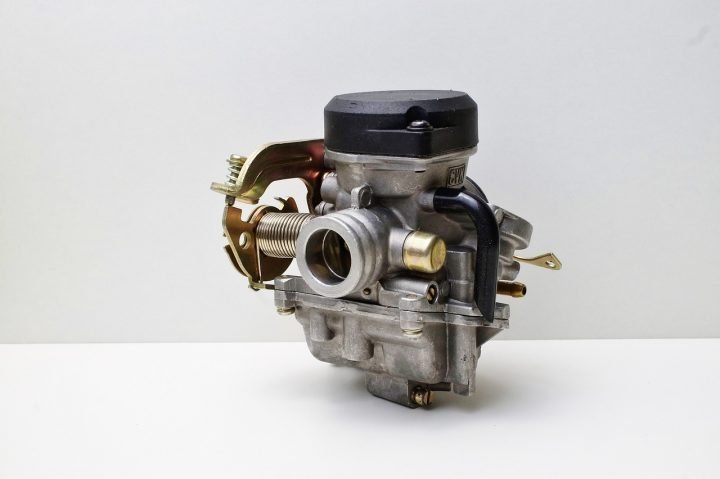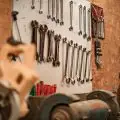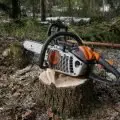Do you struggle to use your chainsaw because you don’t know how to tune it? You must tune a chainsaw by adjusting the carburetor. A carburetor’s high, idle, and low-speed air screws can be simply adjusted for tuning. Don’t worry; if you follow the right carburetor adjustment procedure, tuning a chainsaw is simple.
In this article, you will learn exactly how to tune a chainsaw with the aid of our simple-to-follow 3-step process, along with important tips to keep in mind throughout.
Table of Contents
- Why You Should Tune a Chainsaw?
- Important Tips for Tuning a Chainsaw
- How to Tune a Chainsaw: Adjusting a Chainsaw Carburetor
- Common Mistakes to Avoid When Tuning a Chainsaw
- Are New Chainsaws Already Tuned?
- FAQs (Frequently Asked Questions)

Why You Should Tune a Chainsaw?
Your chainsaw’s carburetor needs to be tuned; else, it may malfunction and be challenging to use. The engine could eventually be damaged if the carburetor is tuned incorrectly. When fine-tuning the chainsaw’s carburetor, caution must be used.
A carburetor controls how much fuel mixes with the air in chainsaws that are driven by fuel. This facilitates the chainsaw’s smooth operation. The engine eventually floods with fuel if too much fuel and air are combined.
Meanwhile, adding insufficient gasoline will reduce the chainsaw’s power and is likely to produce smoke. As a result, there may be some build-up, which can cause harm to the chainsaw’s engine.
What Are the Benefits of Tuning a Chainsaw?
- You’ll be able to reduce your petrol costs while also enhancing engine performance.
- Chainsaw will operate much more efficiently and start up quicker.
- Your chainsaw will operate at its optimum for chopping branches or wood.
- It is crucial for maintaining chainsaws. The gasoline tank should be drained at least once per 20 hours of usage or as directed.
- Owners of chainsaws who experience engine performance concerns should calibrate the carburetor. As a result, the engine response will be longer-lasting and considerably superior.
Important Tips for Tuning a Chainsaw
Before you begin adjusting the chainsaw carburetor, make sure it is positioned flatly on the ground. Verify that the chainsaw is free of unnecessary objects, especially in and around the chain area. Nothing should unintentionally catch on the blades while you are working on the three carburetor adjusting screws.
When using the chainsaw, it’s crucial to put on safety equipment like gloves. Additionally, be sure to wear safety goggles, long pants, and a full-sleeved jacket.
Examine the air filter and, if necessary, clean it. You’ll have to adjust the chainsaw with a filthy filter if you don’t remove the obstructions in time. The chainsaw will eventually run smoothly once the filter has been cleaned. Chainsaw maintenance is imperative.
Keep in mind to check the chainsaw’s fuel level and make a fuel mixture adjustment if necessary. Make sure the fuel tank is at least 50% full. If you adjust the chainsaw with insufficient fuel after the tank is eventually filled, the carburetor may be overly adjusted.
Learn more about fuel ratios in our Can I Use Any 2 Stroke Oil in My Chainsaw? Fuel Oil Ratio Mix Guide!
As a cold engine could give you a rich adjustment, start the engine and let it warm up a little. Turn the screw inward to adjust the low speed until the engine begins to starve, and then take note of the screw’s location. The engine will then run more smoothly if you turn the screw outward. The screw should be installed between the first and second places mentioned. The machine will idle most effectively in this position.
How to Tune a Chainsaw: Adjusting a Chainsaw Carburetor
- Tune the high-speed fuel adjustment screw
- Tune the idle speed screw
- Tune the low-speed fuel adjustment screw
1. Tune the High-Speed Fuel Adjustment Screw
Search for the screw at the top of the spark plug cap after removing the spark plug from the chainsaw. While some also refer to it as an accelerator pump adjustment, this is typically referred to as a “high-speed adjustment screw.”
The amount of air allowed to enter the fuel injector will be managed by the high-speed screw. The screw will be located conveniently on top of the engine and will be directly connected to the throttle trigger.
The correct adjustment setting for the high-speed atmosphere screw should be set. When you start to increase the throttle and the engine begins to choke or flutter, it’s done. To achieve that, you’ll need a flathead screwdriver. Make sure it isn’t sharp enough to harm the engine case’s internal components.
You will obtain the proper RPM, which you may verify with a tachometer. If you need further instructions, always go to the chainsaw manufacturer’s website or the instruction manual.
2. Tune the Idle Speed Screw
Always start by using a tachometer to set a speed of 2700 RPM while altering idle speed. Make sure the chainsaw doesn’t stall out so that it starts running as soon as the throttle is released.
The idle speed adjustment screw should be turned clockwise using a flathead screwdriver. Continue doing this up until the engine starts cutting out at idle. This step will modify how well your chainsaw idles under certain circumstances.
Change the settings to prevent popping and stalling that might happen when switching between different types of gasoline. Due to its location on the side of the engine, the lean or idle speed adjustment screw is rather simple to reach. Your chainsaw will start up more quickly and smoothly once the high-speed adjustment screw and idle speed adjustment screw have been set.
3. Tune the Low-Speed Fuel Adjustment Screw
The low-speed airscrew should be turned clockwise using a flathead screwdriver. Continue doing this until increasing the throttle causes the engine to choke out. You can control how well the chainsaw operates at full power with this step. The fuel injector area is close to where the low-speed adjustment screw is situated. Despite this, it is challenging to see because of the handlebars.
Test out how well your chainsaw runs once you’ve completed adjusting all three adjustment screws. The final procedure will improve the efficiency and maximum power of your chainsaw. Go back to step 1 if you experience any chainsaw issues, like a weak power stroke following your carburetor tuning. Before trying again, you should attempt cleaning any adjustment screws that are challenging to reach.
Common Mistakes to Avoid When Tuning a Chainsaw
- Incorrect fuel pressure
- Not following instructions
- Setting the idle wrong
- Wrong carburetor size
- Letting someone else do it
Incorrect Fuel Pressure
Not getting the proper fuel pressure when tuning a carburetor is the most frequent error. It is advised that you keep the carburetor under constant pressure of 5 to 5.5 PSI, with a maximum of 6.5 PSI. Even using the incorrect amount of fuel in the carburetor might cause harm.
Not Following Instructions
People occasionally assume they know more than they actually do, which leads them to skip reading the instruction manual. Avoid getting ahead of yourself, always follow the correct steps, and exercise caution when adjusting the chainsaw carburetor. Sometimes all it takes to harm your carburetor is one lapse of judgment.
Visit our Chainsaw Tips for Beginners guide if you’re new to chainsaws!
Setting the Idle Wrong
The proper amount of idle mixture screws is included in the carburetor types’ designs in order to maintain an idle fuel flow. They frequently get it right. It’s important to keep in mind that you shouldn’t make any significant changes to the idle speed screws when tuning the chainsaw. Furthermore, you must ensure that the idle is set correctly because a carburetor problem can arise suddenly.
Wrong Carburetor size
A typical beginning error and surefire prescription for disaster are selecting the incorrect carburetor size. It will be best to have a smaller carburetor if your engine is small. The rumor that a bigger engine can be easily jetted in and function the same way is untrue.
Letting Someone Else Do It
Despite the fact that your buddy might be eager to assist with chainsaw maintenance because of your recent purchase, you shouldn’t allow a non-chainsaw expert to even handle your chainsaw, much less tune the carburetor. Even a minor error in carburetor tuning could result in a hefty charge for you. An expert will need to fix the chainsaw if the carburetor is calibrated incorrectly.
Are New Chainsaws Already Tuned?
New chainsaw users occasionally question why their tools can’t be adjusted when they’re brand new and don’t require any tuning. It’s crucial to realize that chainsaws cannot be calibrated at the manufacturer and adjusted for the duration of their useful lives.
The truth is that a few manufacturers have given this some attention and have attempted to fix and partially fix jet carburetors. Such carburetors haven’t operated effectively. The cause is that many parameters, including humidity, gasoline type, fuel age, and elevation, necessitate periodic carburetor adjustments to the carburetors.
It is advantageous to set the carburetor for a variety of applications. For instance, due to the great stress placed on the chainsaw in mills, the high-speed adjustment should be set at high.
Here are a couple of useful YouTube demonstrations to help you, both on Stihl chainsaws:
FAQs (Frequently Asked Questions)
What are the L and H screws on chainsaw?
On a chainsaw, the low and high-speed screws are denoted by the letters “L” and “H,” respectively. The “L” screw controls the amount of fuel injected into the motor at low RPM as well as the speed at which the saw chain moves during cutting (idle to about half). The “H” screw controls the engine’s top speed and prevents the saw from stalling out during cutting. By appropriately adjusting these screws, you can guarantee that the chainsaw is working at its best.
How do I increase the speed of my chainsaw?
With a flathead screwdriver, turn the idle speed screw clockwise until the engine chokes off before increasing the chainsaw’s speed. The saw should then be warmed up and given 30 seconds to rest. To get the highest RPM, adjust the three carburetor screws, idle speed, low speed, and high speed/high mixture. Finally, lean the high speed rich out to increase speed before adjusting it to slow down and stop.





